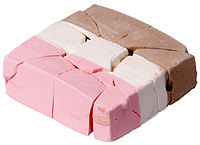
Photo from wikipedia
This study investigated the effect of different drying techniques, namely, room-temperature drying (RTD), solar drying (SD), heat-pump drying (HPD), hot-air drying (HAD), and freeze drying (FD), on bioactive components, fatty… Click to show full abstract
This study investigated the effect of different drying techniques, namely, room-temperature drying (RTD), solar drying (SD), heat-pump drying (HPD), hot-air drying (HAD), and freeze drying (FD), on bioactive components, fatty acid composition, and the volatile compound profile of robusta coffee beans. The data showed that FD was an effective method to preserve fat, organic acids, and monounsaturated fatty acids. In contrast, HAD was ideal for retaining polyunsaturated fatty acids and amino acids. Sixty-two volatile compounds were identified in the differently dried coffee beans, representing 90% of the volatile compounds. HPD of the coffee beans produced the largest number of volatiles, whereas FD resulted in the highest volatile content. A principal component analysis demonstrated a close relationship between the HPD, SD, and RTD methods whereas the FD and HAD methods were significantly different. Overall, the results provide a basis for potential application to other similar thermal sensitive materials.
Journal Title: Food chemistry
Year Published: 2017
Link to full text (if available)
Share on Social Media: Sign Up to like & get
recommendations!